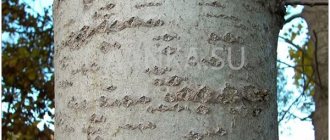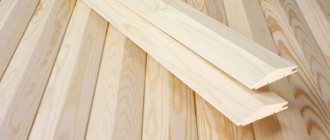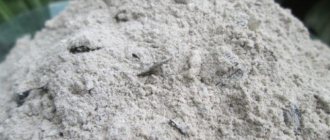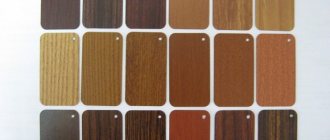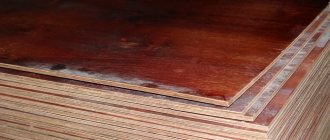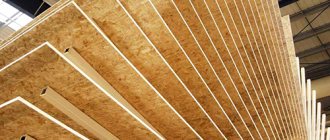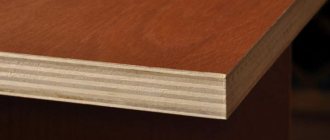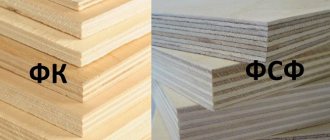Both of these types of plywood are widely used, affordable and easy to use. The scope of application of FC and FSF plywood is industrial production, packaging, construction, car and machine building. The versatility of the material has been proven over years of use for finishing walls, floors, ceilings, partitions, construction, and design. Let's try to figure out the differences between FK plywood and FSF plywood, and how they can be distinguished visually.
The main difference between FC and FSF plywood
FC material is characterized by versatility in terms of application and high strength. Not intended for use in conditions of high humidity. The main advantage is low cost compared to FSF materials. The main scope of application is the arrangement of floors (used as a substrate for parquet, laminate), furniture production, interior decoration, production of containers and packaging.
The raw materials for the production of FC are mainly peeled birch, alder, other deciduous trees, and sometimes a combination of several types of wood. Moisture has a negative effect on the inner layers of the material: it deforms, leads to twisting, and delamination. The maximum sheet thickness can reach 40 mm. There are several varieties, depending on the presence and number of knots.
FSF, on the contrary, is moisture resistant, due to which it is widely used in conditions of high humidity. For example, for external and internal roofing work. The material is durable, resistant to mechanical damage and wear.
The raw materials for production are coniferous wood and birch. To impart moisture and fire resistance during the production process, it is treated with appropriate compounds. It is used in aircraft and mechanical engineering, industrial production and construction work.
Varieties and labeling
There are five grades of plywood.
The highest is E (Elite), and then, as it gets worse, from I to IV. The grade is determined by the condition of the upper - front layers. Moreover, the quality of both surfaces is assessed separately and written through a slash. For example, I/II or III/IV. GOST describes in detail what surface errors are permissible for which grade; there are special tables by which this grade is determined. If at least one parameter is worse than acceptable, the grade is reduced.
Varieties differ in the presence and size of certain defects
Here are the features on the front surface that different types of plywood may have.
- Elite For this brand of plywood, the veneer must be perfect. There may only be minor changes to the wood (no eyes). All. There should be no other shortcomings.
- I grade. There may be knots: pin knots, no more than 3 pieces per square meter;
- healthy, fused, dark and light with a diameter of 15 mm, no more than 10 pieces/m², they may have cracks no more than 0.5 mm wide;
- partially fused, not fused, falling out with a diameter of no more than 6 mm in an amount of no more than 3 pcs/m²;
- Knots: pin knots without restrictions;
- Knots: pin knots without restrictions;
- length no more than 300 mm no more than 2 pieces,
- Knots: pin knots;
- length no more than 300 mm without restrictions;
Correspondence of plywood grade designations according to various standards: GOST 3916.1-96, TU 5512-002-00255214-2000, GOST 10.55-71
If there are defects not listed in GOST, the product is considered substandard. It is also considered substandard if the maximum permissible size of defects is exceeded. Sometimes they try to sell such products as a fourth grade, but this is a re-grade and the price for it should be significantly lower.
By the way, if there are no obvious cracks or fallen knots, the third grade can be used for interior finishing. In certain interiors it looks even more interesting than E or the first, which are simply a flat sheet without any features inherent in wood.
How to choose?
When building a house, plywood is most often used, consisting of 3-5 layers of glued veneer. Veneer layers can be arranged in different ways in the sheet material; they are assessed based on the outer layers of the sheet. If the wood fibers are located in the direction of the length of the sheet, then such plywood is called longitudinal. If the fibers are located in the direction of the width of the sheet, then such plywood is considered to be transverse. Longitudinal sheet plywood is used where high flexibility of the sheet is required when performing work. Transverse plywood is used in cases where good rigidity is required, which occurs when this material bends.
Due to the impregnation of the layers with glue, plywood sheets are highly resistant to humidity and water. The most common are several brands.
FC - is a moisture-resistant sheet, the veneer inside of which is impregnated with glue consisting of a mixture of resin and formaldehyde. If plywood has an E1 impregnation class, it means that the degree of release of formaldehyde vapor into the external environment is low, and such material can be used in residential premises.
Finished sheets of pressed plywood are sanded.
There are two types of plywood products.
Sanded - if only one side of the sheet is sanded, then the code Ш1 is added to the nomenclature of the plywood grade. If both sides are sanded, then the product is marked with the code Ш2.
Plywood, sanded on both sides, is used for the production of furniture products. If you are choosing a material for construction work, then it makes no sense to overpay for sanded sheets - you can get by with a cheaper unsanded option.
Plywood sheets are divided into 5 grades. The best grade is marked with the letter E, which denotes elite and high quality products. Then, as they deteriorate, varieties are divided into I, II, III and IV. The grade is determined by the appearance and quality of the front sides of the material. Each side is evaluated separately, and the result in the nomenclature is written using a fraction sign. For example, plywood marked I/II will indicate that one side of this material corresponds to grade I, and the second side of the sheet has only grade II quality.
To correctly determine the amount of material needed for work, you need to make preliminary calculations before purchasing:
- determine the area of the plywood sheet;
- calculate the working surface area;
- divide the area of the working surface by the area of the plywood sheet, rounding the result up to whole numbers upward.
When purchasing material, you need to take a small supply, which will be needed in case of an unforeseen cut.
Experienced specialists recommend taking into account the following important nuances when purchasing plywood material:
determine the purpose of plywood and select the appropriate grade of material for this purpose, and also take into account the composition of the adhesive base; check with the seller what material the plywood sheets are made of - birch and pine wood are considered the most suitable for interior and exterior work; pay attention to the quality of the sheet surface - there should be no chips, bubbles or foreign inclusions on it.
For the manufacture of furniture products, plywood sheets are used, the thickness of which does not exceed 9-10 mm, while for construction purposes they take material with a thickness of at least 12 mm. Finishing work is carried out using sanded plywood of grade E or category I with mandatory sanding of the outer side. For other work, the appropriate class of material is also individually selected and the need for grinding is determined. The cost of a plywood sheet directly depends on its grade, size and thickness. The larger the dimensions of the sheet and its thickness, the more expensive the material is.
Which plywood is better, see below.
Alternative use of these building materials
If you are not fixated on purchasing any of the above-mentioned plywood, then in this case, the most appropriate option would be to purchase sheets marked FB. This plywood combines the advantages of using both of these materials. It has the opportunity to boast of having really high characteristics, which are determined by the peculiarities of its production. This veneer is impregnated with a special bakelite varnish, which ensures truly impressive physical and technical characteristics!
The concept of “plywood” is a collective term that combines sheets glued together from three or more layers of wood veneer. Wood fibers are usually perpendicular, which allows plywood to hold its shape and resist dynamic loads.
Currently, FC
and
FSF
. However, disputes between finishers about the quality of products and their environmental safety continue. Let's try to understand this issue.
Moisture resistance
There are several varieties of plywood regarding its moisture resistance. They have a specific designation, which is indicated in the labeling. The FSF type material is moisture resistant. This is resin formaldehyde plywood. Moisture-resistant laminated plywood FSF, unlike other types (FP, FBA), is resistant to such influences. It can be used outdoors. This is explained by the peculiarities of its production.
The material contains glue based on a phenolic component. It is this that gives plywood its moisture-resistant qualities. However, phenol-formaldehyde glue also has a number of disadvantages. It is not a safe substance. Phenol formaldehyde can be harmful to human health.
It is worth noting that in the production of waterproof plywood covered with a layer of special film, glue with a safety class of at least E1 is used. This allows the presented type of plywood to be used even indoors. It is allowed to make furniture from such material, including for children's rooms. At the same time, the content of formaldehyde components in the composition is minimal.
When purchasing moisture-resistant laminated plywood for flooring, creating furniture or products made from similar materials, you should give preference to products from trusted brands. Only such manufacturers comply with all GOST requirements. Their products are safe for human health. Little-known manufacturers may skimp on quality, which results in plywood with a persistent chemical odor. If you notice an unpleasant, strong aroma of formaldehyde, such products should not be purchased for indoor use.
Also waterproof materials include plywood such as FOF, FBS, FK.
